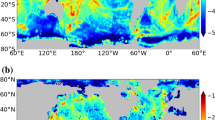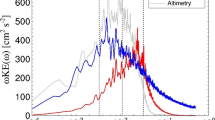Abstract
The global distributions of the major semidiurnal (M2 and S2) and diurnal (K1 and O1) baroclinic tide energy are investigated using a hydrostatic sigma-coordinate numerical model. A series of numerical simulations using various horizontal grid spacings of 1/15–1/5° shows that generation of energetic baroclinic tides is restricted over representative prominent topographic features. For example, nearly half of the diurnal (K1 and O1) baroclinic tide energy is excited along the western boundary of the North Pacific from the Aleutian Islands down to the Indonesian Archipelago. It is also found that the rate of energy conversion from the barotropic to baroclinic tides is very sensitive to the horizontal grid spacing as well as the resolution of the model bottom topography; the conversion rate integrated over the global ocean increases exponentially as the model grid spacing is reduced. Extrapolating the calculated results in the limit of zero grid spacing yields the estimate of the global conversion rate to be 1105 GW (821, 145, 102, 53 GW for M2, S2, K1, and O1 tidal constituents, respectively). The amount of baroclinic tide energy dissipated in the open ocean below a depth of 1000 m, in particular, is estimated to be 500–600 GW, which is comparable to the mixing energy estimated by Webb and Suginohara (Nature 409:37, 2001) as needed to sustain the global overturning circulation.








Similar content being viewed by others
References
Blumberg AF, Mellor GL (1987) A description of a three-dimensional coastal ocean circulation model. In: Heaps N (ed) Three-dimensional coastal ocean models. AGU, Washington, DC
Carter GS, Merrifield MA, Becker JM, Katsumata K, Gregg MC, Luther DS, Levine MD, Boyd TJ, Firing YL (2008) Energetics of M2 barotropic-to-baroclinic tidal conversion at the Hawaiian Islands. J Phys Oceanogr 38(10):2205–2223
Decloedt T, Luther DS (2010) On a simple empirical parameterization of topography-catalyzed diapycnal mixing in the abyssal ocean. J Phys Oceanogr 40(3):487–508
Egbert GD, Ray RD (2000) Significant dissipation of tidal energy in the deep ocean inferred from satellite altimeter data. Nature 405(6788):775–778
Ferrari R, Wunsch C (2009) Ocean circulation kinetic energy: reservoirs, sources and sinks. Annu Rev Fluid Mech 41:253–282
Furuichi N, Hibiya T, Niwa N (2008) Model-predicted distribution of wind-induced internal wave energy in the world’s oceans. J Geophys Res 113(C09034). doi:https://doi.org/10.1029/2008JC004768
Hasumi H, Suginohara N (1999) Effects of locally enhanced vertical diffusivity over rough bathymetry on the world ocean circulation. J Geophys Res 104(C10):23367–23374
Iwamae N, Hibiya T, Watanabe M (2009) Numerical study of the bottom-intensified tidal mixing using an “eikonal approach”. J Geophys Res 114(C05022). doi:https://doi.org/10.1029/2008JC005130
Jayne SR, St. Laurent LC (2001) Parameterizing tidal dissipation over rough topography. Geophys Res Lett 28(5):811–814
Kantha LH, Tierney CC (1997) Global baroclinic tides. Prog Oceanogr 40:163–178
Kuhlbrodt T, Griesel A, Montoya M, Levermann A, Hofmann M, Rahmstorf S (2007) On the driving processes of the Atlantic meridional overturning circulation. Rev Geophys 45(RG2001). doi:https://doi.org/10.1029/2004RG000166
Levitus S, Boyer TP (1994) World ocean atlas 1994. In: NOAA atlas NESDIS 4, vol 4: temperature. US Dept of Commerce, Washington DC
Levitus S, Burgett R, Boyer TP (1994) World ocean atlas 1994. In: NOAA atlas NESDIS 3, vol 3: salinity. US Dept of Commerce, Washington DC
Matsumoto K, Takanezawa T, Ooe M (2000) Ocean tide models developed by assimilating Topex/Poseidon altimeter data into hydrodynamical model: a global model and a regional model around Japan. J Oceanogr 56(5):567–581
Morozov EG (1995) Semidiurnal internal wave global field. Deep Sea Res Part I 42(1):135–148
Munk WH (1981) Internal waves and small-scale processes. In: Warren BS, Wunsch C (eds) Evolution of physical oceanography. MIT Press, Cambridge
Munk WH, Wunsch C (1998) Abyssal recipes II: energetics of tidal and wind mixing. Deep Sea Res Part I 45(12):1977–2010
Nakamura T, Isoda Y, Mitsudera H, Takagi S, Nagasawa M (2010) Breaking of unsteady lee waves generated by diurnal tides. Geophys Res Lett 37(L0462). doi:https://doi.org/10.1029/2009GL041456
Niwa Y, Hibiya T (2004) Three-dimensional numerical simulation of M2 internal tides in the East China Sea. J Geophys Res 109(C04027). doi:https://doi.org/10.1029/2003JC001923
Nycander J (2005) Generation of internal waves in the deep ocean by tides. J Geophys Res 106(C10028). doi:https://doi.org/10.1029/2004JC002487
Pacanowski RC, Philander SGH (1981) Parameterization of vertical mixing in numerical models of tropical oceans. J Phys Oceanogr 11(11):1443–1451
Schmitz WJ (1995) On the interbasin-scale thermohaline circulation. Rev Geophys 33(2):151–174
Simmons HL, Hallberg RW, Arbic BK (2004) Internal wave generation in a global baroclinic tide model. Deep Sea Res Part II 51(25–26):3043–3068
Sjöberg B, Stigebrandt A (1992) Computations of the geographical distribution of the energy flux to mixing processes via internal tides and the associated vertical circulation in the ocean. Deep Sea Res Part A 39(2A):269–291
Smith WHF, Sandwell DT (1997) Global sea floor topography from satellite altimetry and ship depth soundings. Science 277(5334):1956–1962
St. Laurent LC, Simmons HL, Jayne SR (2002) Estimating tidally driven mixing in the deep ocean. Geophys Res Lett 29(2016). doi:https://doi.org/10.1029/2002GL015633
Tanaka Y, Hibiya T, Niwa Y, Iwamae N (2010) Numerical study of K1 internal tides in the Kuril Straits. J Geophys Res 115(C09016). doi:https://doi.org/10.1029/2009JC005903
Webb DJ, Suginohara N (2001) Vertical mixing in the ocean. Nature 409(6816):37
Zhai X, Greatbatch RJ, Eden C, Hibiya T (2009) On the loss of wind-induced near-inertial energy to turbulent mixing in the upper ocean. J Phys Oceanogr 39(11):3040–3045
Zilberman N, Becker JM, Merrifield MA, Carter GS (2009) Model estimates of M2 internal tide generation over Mid-Atlantic Ridge topography. J Phys Oceanogr 39(10):2635–2651
Author information
Authors and Affiliations
Corresponding author
Rights and permissions
About this article
Cite this article
Niwa, Y., Hibiya, T. Estimation of baroclinic tide energy available for deep ocean mixing based on three-dimensional global numerical simulations. J Oceanogr 67, 493–502 (2011). https://doi.org/10.1007/s10872-011-0052-1
Received:
Revised:
Accepted:
Published:
Issue Date:
DOI: https://doi.org/10.1007/s10872-011-0052-1




